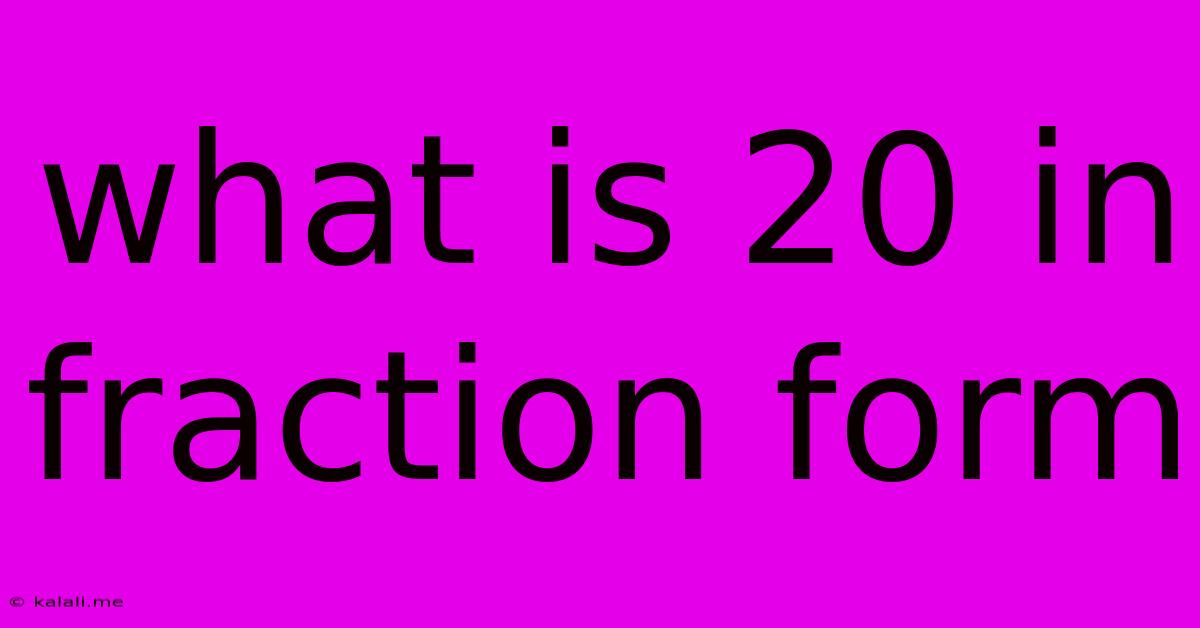What Is 20 In Fraction Form
Kalali
May 10, 2025 · 2 min read

Table of Contents
What is 20 in Fraction Form? Understanding Whole Numbers as Fractions
This seemingly simple question, "What is 20 in fraction form?", opens the door to understanding a fundamental concept in mathematics: the relationship between whole numbers and fractions. While it might seem obvious that 20 is just 20, expressing it as a fraction allows for greater flexibility in mathematical operations and problem-solving. This article will explore several ways to represent 20 as a fraction, explaining the underlying principles and providing examples.
Understanding Fractions
A fraction represents a part of a whole. It's composed of two numbers: the numerator (the top number) and the denominator (the bottom number). The denominator indicates how many equal parts the whole is divided into, while the numerator shows how many of those parts are being considered.
Representing 20 as a Fraction
The simplest way to represent 20 as a fraction is to use 1 as the denominator. This is because any number divided by 1 equals itself. Therefore:
20/1
This fraction clearly shows that we have 20 out of 20 equal parts (or the entire whole).
Other Fraction Representations of 20
However, there are infinitely many ways to represent 20 as a fraction. We can achieve this by multiplying both the numerator and denominator by the same number. For example:
- 40/2: (20 x 2) / (1 x 2)
- 60/3: (20 x 3) / (1 x 3)
- 80/4: (20 x 4) / (1 x 4)
- 100/5: (20 x 5) / (1 x 5)
and so on... Each of these fractions is equivalent to 20. The key is that the ratio between the numerator and the denominator remains the same.
Why Use Different Fraction Representations?
While 20/1 is the simplest representation, using other equivalent fractions can be beneficial in various mathematical contexts. For example:
- Simplifying Complex Fractions: If you're working with a more complex fraction that involves 20, expressing 20 as an equivalent fraction might simplify the calculation.
- Common Denominators: When adding or subtracting fractions, having a common denominator is crucial. Representing 20 as a fraction with a common denominator allows for easier calculations.
- Problem Solving: In word problems, representing a whole number as a fraction might be necessary to align it with the fractional parts of the problem.
Conclusion:
In conclusion, while 20 can be simply written as 20, expressing it as a fraction offers flexibility and expands its use in various mathematical applications. Understanding the equivalence of fractions and the different ways to represent a whole number as a fraction is crucial for developing a solid mathematical foundation. The simplest representation is 20/1, but many other equivalent fractions exist, each useful in specific contexts. Remember the core principle: multiplying or dividing both the numerator and the denominator by the same number maintains the value of the fraction.
Latest Posts
Latest Posts
-
How Tall Is A 3 Story Building
Jul 03, 2025
-
Is Miranda Cosgrove Related To Jimmy Fallon
Jul 03, 2025
-
What Is 1 4 Of A 1 4 Cup
Jul 03, 2025
-
What Is 20 Percent Off Of 39 99
Jul 03, 2025
-
Where Is The 3 In Riddle Transfer
Jul 03, 2025
Related Post
Thank you for visiting our website which covers about What Is 20 In Fraction Form . We hope the information provided has been useful to you. Feel free to contact us if you have any questions or need further assistance. See you next time and don't miss to bookmark.